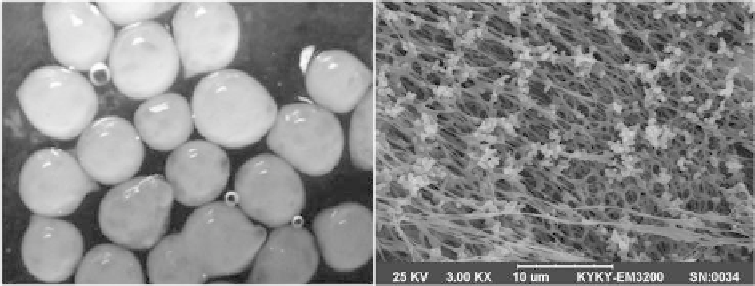Environmental Engineering Reference
In-Depth Information
Figure 11.4.6
Immobilized solid support matrices and their scanning electron microscope images
(Tian et al., 2009).
can emit light laterally from their surface, enhancing the efficient distribution of light
to the cells and thereby improving the photobiohydrogen production performance.
In addition, the mechanical stability and resistance to oxygen were also obtained by
coating the immobilized cells with a transparent layer of gellan gum.
To reduce the mass transfer resistance by the cell entrapment, polyvinyl alcohol-
boric acid gel granule was used to immobilize the indigenous photosynthetic bacteria
Rhodopseudomonas palustris
CQK 01 (Tian et al., 2009). As shown in Figure 11.4.6,
this type of gel granule has numerous pores which are mutually connected and cells are
then firmly attached to the surface of the solid support matrix. These stable net-work
matrices created a biocompatible environment and in the meantime high porosity pro-
vided the sufficient space for the bacterial growth, facilitating the transfer of substrate,
water, and products. This team also adopted a photobioreactor packed with sodium
alginate/polyvinyl alcohol-124/carrageenan granules containing
Rhodopseudomonas
palustris
CQK 01 for photobiohydrogen production in a continuous operational mode
(Wang et al., 2010). With this design, the mass transfer resistance was reduced and
the maximal photobiohydrogen production rate of 2.61 mmol/L/h was achieved. As
mentioned in the above section, the photobiohydrogen production by photosynthetic
bacteria can simultaneously realize the energy production and wastewater treatment.
Zhu et al. (1999) used the wastewater of tofu factory as carbon source and anoxy-
genic phototrophic bacterium
Rhodobacter sphaeroides
immobilized in agar gels. The
bacterium could be protected by the immobilization from the inhibitory effect of
ammonium ion. The results showed that the maximum photobiohydrogen produc-
tion rate obtained was 2100 ml/h/m
2
along with a yield of hydrogen of 0.24 ml/mg the
total organic carbon removal ratio reached 41% in 85 h.
11.4.3.2 Biofilm
Another immobilization technique is the biofilm technique. Compared with cell entrap-
ment, the biofilm technique can not only increase the biomass concentration but also
lower the mass transfer resistance as a result of thin biofilm thickness, causing high pho-
tobiohydrogen production performance, sufficient light supply and weakened product

Search WWH ::

Custom Search